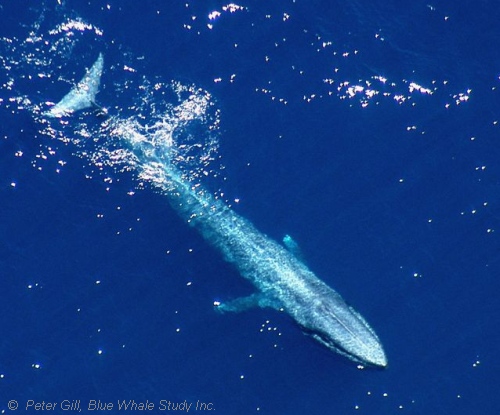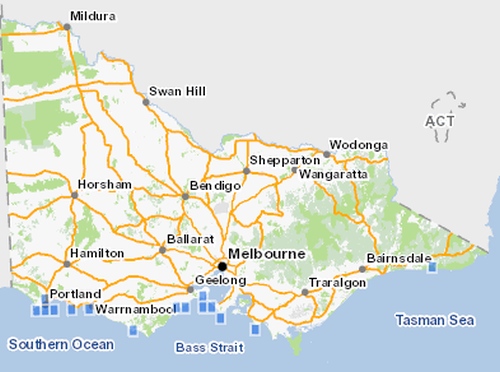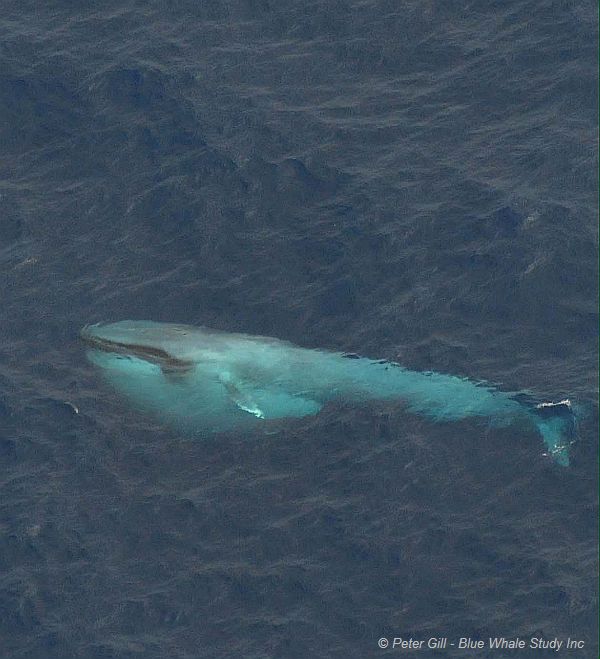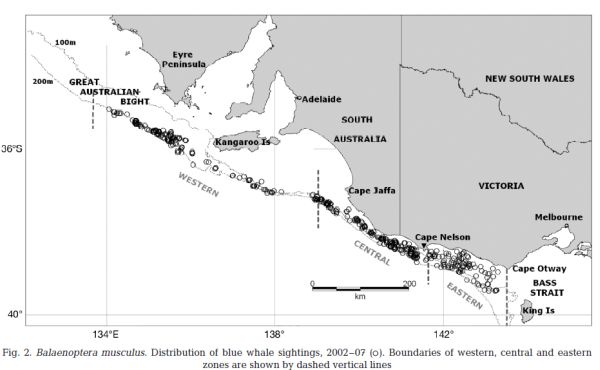Blue Whale
Blue WhaleBalaenoptera musculus | |
|---|---|
| Kingdom: | Animalia |
| Phylum: | Chordata |
| Class: | Mammalia |
| Order: | Cetacea |
| Family: | Balaenidae |
| Status | |
| World: | Endangered (IUCN Red List) |
| Australia: | Endangered (EPBC Act 1999) |
| Victoria: | Endangered (FFG Threatened List 2025) |
| FFG: | Listed (Action Statement No.247) |

The Blue Whale is one of six species in the family Balaenopteridae; it is the largest animal known to have lived and inhabits all oceans of the world. It is a baleen whale, with a wall of black fibrous keratin plates (baleen) hanging on the upper jaw, which is used to filter out food. Also referred to as rorqual whale, it has a pleated throat and ventral grooves that expand to allow large volumes of water and food to be taken when feeding.
Three subspecies are recognised:
Northern Hemisphere Blue Whale Balaenoptera musculus musculus (average length 25m),
‘True’ Blue Whale Balaenoptera musculus intermedia (average length 27 metres) occurring in Antarctic waters
Pygmy Blue Whale Balaenoptera musculus brevicauda (average length 22 metres) occurring only in the Southern Hemisphere and generally north of the Antarctic convergence (lat. 55o-60oS).
Distinctive features of the Blue Whale include; long streamline shape, small triangular dorsal fin positioned far back on the body, pointed flippers and a single prominent ridge along the upper surface of the head ending in a prominent knob around the blowholes. Field identification between sub-species is difficult with migratory range being one of the main differences.1
Distribution

Ecology & Habitat
The true Blue Whale migrates to circumpolar Antarctic waters during the summer months feeding mainly on krill Euphausia superba from the ice pack to the Antarctic convergence. Pygmy Blue Whales inhabit a zone generally north of the Antarctic convergence.1, 2
Pygmy Blue Whales occur in the South West of Victoria on the continental shelf between Cape Otway, Victoria to Robe, South Australia. Sightings occur from November through to May and are associated with feeding on krill Nyctiphanes australis which form surface swarms in response to predictable wind forced upwelling of cool nutrient rich water named the Bonney Upwelling.3
Blue Whales live about 80-90 years and can weigh in excess of 130 tonnes, they are slow to mature with a low reproductive rate of one calf every 2-3 years.4, 5

Threats
The Blue Whale has been hunted close to extinction. In the first half of the 20th Century estimates of around 350,000 were killed mostly in Antarctic waters. Catches peaked in the 1930-31 season when 30,000 were taken worldwide; by 1963, due to the scarcity of whales the catch comprised only 1,000.4, 6
Current threats include: noise from marine industries, entanglement in commercial fishing gear, interference in feeding areas, collision with ships, ingestion of pollutants from oil spills & marine debris such as plastics. Other threats, which could impact on the entire population, include potential commercial expansion of the Antarctic and sub-Antarctic krill fishery which could result in more competition for the krill resource and less food available for Blue Whales.
Global warming has the potential to impact on the availability of Antarctic Krill Euphausia superba in the Antarctic region, which is a crucial source of food for Blue Whales to survive. Implications for krill include a reduction in the area of sea ice, which is necessary for krill recruitment, changes in sea temperature and changes to upwelling of nutrient rich currents, which provide a food source to support krill stocks .7
Conservation & Management
Manage the potential impacts of whale watching, ecotourism through the application of Victorian and Commonwealth whale watching regulations. Assess and manage physical disturbance and development activities such as shipping (collision with ships), aquaculture, pollution, recreational boating, and oil & gas exploration and extraction industries – including the application of environmental impact assessment and approvals and the development of industry guidelines and State/Commonwealth government regulations.
The Blue Whale Study
A paper by Gill et.al 2011on six years of observations of Blue Whales at the Bonney Upwelling has been published. Blue whale habitat selection and within-season distribution in a regional upwelling system off southern Australia. Marine Ecology Progress Services Vol 421; 243-263, 2011. Inter-Research 2011
Some interesting points from Gill et.al 2011 research 8
- Three physiographically discrete regions have been identified and described in the above paper. The Western Zone (a relatively wide continental shelf of 60 to 160 km). The Central Zone, which has the narrowest shelf along most of Australia’s southern coast (25 to 80 km) and the Eastern Zone which is intermediate in shelf width (50 to 80 km) (see map).

- A total of 69 aerial surveys were flown between the 2001/02 season and 2006/07 season. For the Central and Eastern Zones i.e. Bonney Upwelling waters off south eastern South Australia and south west Victoria the combined count for each season was 2001/02 (44); 2002/03 (68); 2003/04 (108); 2004/05 (79); 2005/06 (27); 2006/07 (14).
- Blue Whales arrive at the Bonney Upwelling by mid November and depart by the end of April. There is a shift in densities between the zones as the season progresses with Blue Whales restricted to the western/central zone in November, entering the eastern zone in December, and widely spread through the central and eastern zones during January, February, March, and April.
- The two most significant variables explaining Blue Whale distribution were found to be Sea Surface Temperature (increasing probability of sightings with warmer water) and Sea Surface Chlorophyll (increasing probability with higher levels) these variables tend to be related to each other.
- In the central and eastern zones study area combined, 93% of blue whale sightings occurred in depths less than 200 m.
References & Links
1 Ichihara, T. (1966) The Pygmy Blue Whale, Balaenoptera musculus brevicauda, a new sub-species from the Antarctic. In Whales Dolphins & Porpoises, pp. 79-124, Ed. Norris, K.S., University of California Press, Berkeley and Los Angeles 1966.
2 Kato, H., Miyashita, T., Shimada, H., (1995) Segregation of the Two Sub-species of the Blue Whale in the Southern Hemisphere, RPT. INT. WHAL. COMMN. 45, 273-283, 1995, SC/46/SH10.
3 Gill, P.C., (2002) A Blue Whale (Balaenoptera musculus) feeding ground in a southern Australian coastal upwelling zone, J. Cetacean. Res. Manage. 4(2): 179-184, 2002
4 Sears, R., (2002) Blue Whale Balaenoptera musculus, Encyclopedia of Marine Mammals, Ed. Perrin, W., Wursig, B., Thewissen, J.G.M., Academic Press.
5 Yochem, P.K. & Leatherwood, S. (1985) Blue Whale Balaenoptera musculus (Linnaeus, 1758), Handbook of Marine Mammals Vol. 3, The Sirenians and Baleen Whales, Academic Press (London) Ltd.
6 Everson, I. (1977) The living resources of the Southern Ocean, Rome: Food and Agriculture Organisation of United Nations, Southern Ocean Fisheries Survey Program GLO/SO/77/1
7 Thiele, D. (2001) Preliminary report on IWC-SO GLOBEC collaborative research in the Western Antarctic Peninsula Study Area; June 2001.
8 Gill, P.C., Morrice, M.G., Page, B., Pirzl, R., Levings, A.H., Coyne, M. (2011) Blue whale habitat selection and within-season distribution in a regional upwelling system off southern Australia. Mar Ecol Prog Ser Vol. 421: 243–263, 2011, doi: 10.3354/meps08914. (pdf 2.2MB)
9 Victorian Biodiversity Atlas, Department of Environment, Land, Water & Planning, Victoria. Accessed: October, 2015.
FFG Threatened List (2025) Flora and Fauna Guarantee Threatened List, Department of Energy, Environment and Climate Action (DEECA), Victoria.
More Information
Please contribute information regarding the Blue Whale in Victoria - observations, images or projects. Contact SWIFFT

